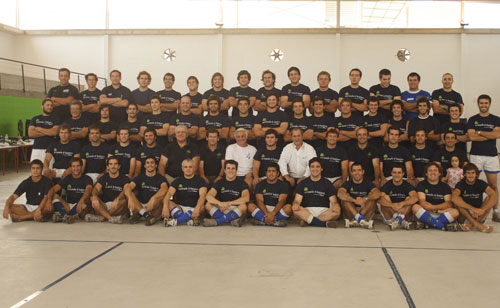The
modern game
Argentina
played its first full international game against a touring
British Isles team in 1910. Distance, two World Wars and
lack of funding limited international involvement until
the later decades of the century. The game spread within
Argentina itself. There are eighty clubs in the greater
Buenos Aires area and about four hundred throughout the
country. In the Northwest, the game comes close to
surpassing football in popularity. More than seventy
private schools, mostly bilingual as a result of British
and Irish influence, and twenty universities,
predominantly in the Buenos Aires area, have their own
rugby teams. Women’s rugby has begun to develop in a
handful of clubs. The season runs from March to November.
This has enticed European teams to tour there for an easy
run up to the Six Nations, only to be severely mauled by
the Pumas. There have also been Irish links with the Pumas:
two coaches were of Irish origin, Adolfo ‘Michingo’
O’Reilly during the 1980s and Dermot Cavanagh during the
1960s. There have also been players of Irish origin,
including Santiago Phelan, who played in the late 1990s
and retired in 2003.
In their
first World Cup, the Pumas scored a win over Italy but
finished bottom of their pool on points difference. In
subsequent World Cup tournaments and Test Series they
scored notable wins over all the Six Nations teams and
gave the All Blacks a severe fright, allaying any notion
that they are a second-tier force in the rugby world. In
the 2007 World Cup they devastated Ireland and went on to
destroy the reigning champions, France, twice, coming
third overall in the tournament. Many Argentinean players
play professional rugby in Europe including Agustín Pichot,
Felipe Contepomi and Juan Martin Hernández. Contepomi, a
graduate of Cardenal Newman College, playing for Leinster,
was named as the sports writers’ player of the year in
Ireland in 2007. He made his international debut against
Uruguay in 1995 and established himself as a formidable
force with Bristol in England and later with Leinster,
enabling him to complete his medical studies in Ireland.
Although
the UAR considered a change to its statutes which would
allow professionalism in Argentina’s domestic leagues,
this was unanimously rejected in an extraordinary meeting
in January 2008. Whilst some were pushing for inclusion in
the Six Nations competition, it seems more likely that
Argentina’s future lies with the Tri-Nations competition
in the Southern hemisphere.
|

A very pleased Old Christians team,
including Roberto Canessa (left) and Gustavo Zerbino
(right), both Andes survivors. Gustavo is the
current president of the Uruguay Rugby Union (URU)
(photographer unknown) |
On the
opposite bank of the Plate, the game similarly remains
steadfastly amateur. After the formation of the Uruguay
Rugby Union (URU) in 1951, four teams took part in the
first club tournament: Carrasco Polo, Colonia Rugby (now
defunct), Old Boys and Montevideo Cricket. Since then Old
Christians, Los Cuervos, Champagnat and El Trébol (Paysandú)
have joined the competition. Carrasco Polo has been the
dominant champion for most of this time, winning
twenty-one championships, followed by Old Christians with
sixteen. Old Christians won the Championship in 2007.
Brother McGuinness, speaking from retirement in County
Kilkenny, expressed regret that the game was changing from
an open, running game to one of ‘big hits’ and increased
physical contact. He kept a close eye on the rugby scene
in Uruguay. He maintained that Carrasco Polo retained its
dominance by recruiting the biggest players available.
The Punta
del Este Sevens attract the best players in South America
and formerly some of the most outstanding players in the
world, such as Jonah Lomu. The tournament is a major
tourist attraction in Punta del Este and one of the
highlights of the rugby year in the region. The URU puts a
great deal of effort into organising youth rugby in the
country by encouraging clubs and schools. In this way they
have enlarged the pool of up-and-coming players, to the
benefit of the clubs and ultimately, it is hoped, the
national team, Los Teros.
[12] On the international level
Los Teros have won twenty, drawn one and lost
thirty-eight. Notable wins were against Georgia in the
World Cup in Australia; 18-12
against Portugal in 2007, following a previous defeat;
43-15 against Chile in 2006 and a spectacular recovery
against Chile in 2007, coming from 27-0 at half-time to
win by 35-34.
Unfortunately they failed to qualify for the World Cup in
France in 2007.
Hugh
FitzGerald Ryan
Acknowledgements
I am very
grateful to Roberto Canessa, Daniel Etchegorry, Bro. John
McGuinness RIP (as I understand from his colleagues in
Kilkenny, Brother McGuinness died on 28 October 2007, just
a few days before Old Christians won the championship),
and to William Revetria, Gabriela Viera, the teachers of
Stella Maris and the members of Old Christians, for their
help, guidance and recollections about rugby in Uruguay.
|

